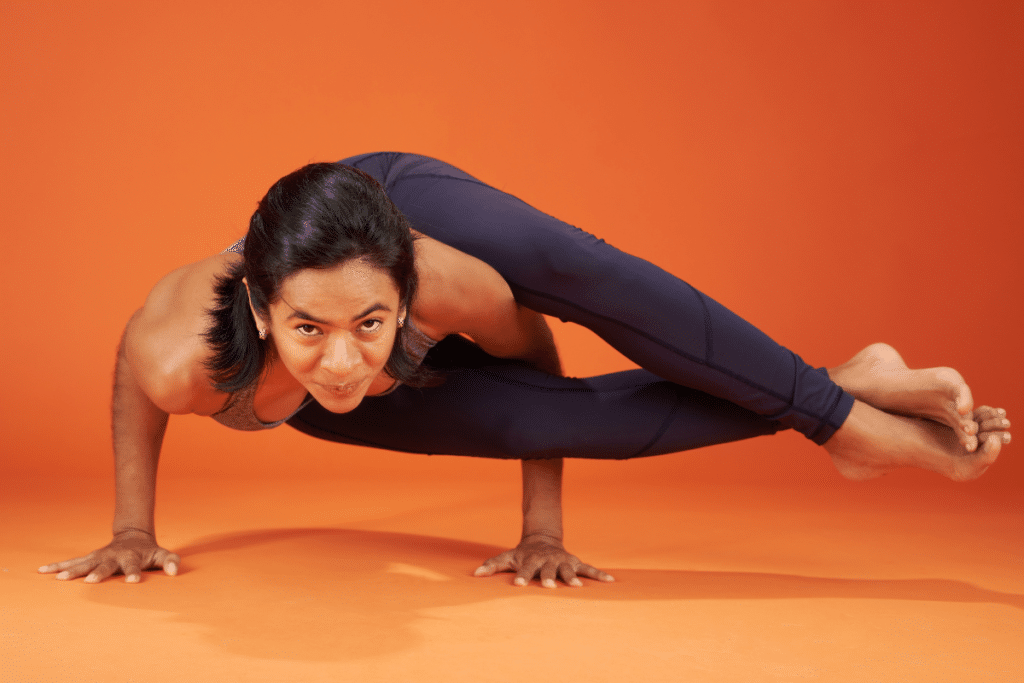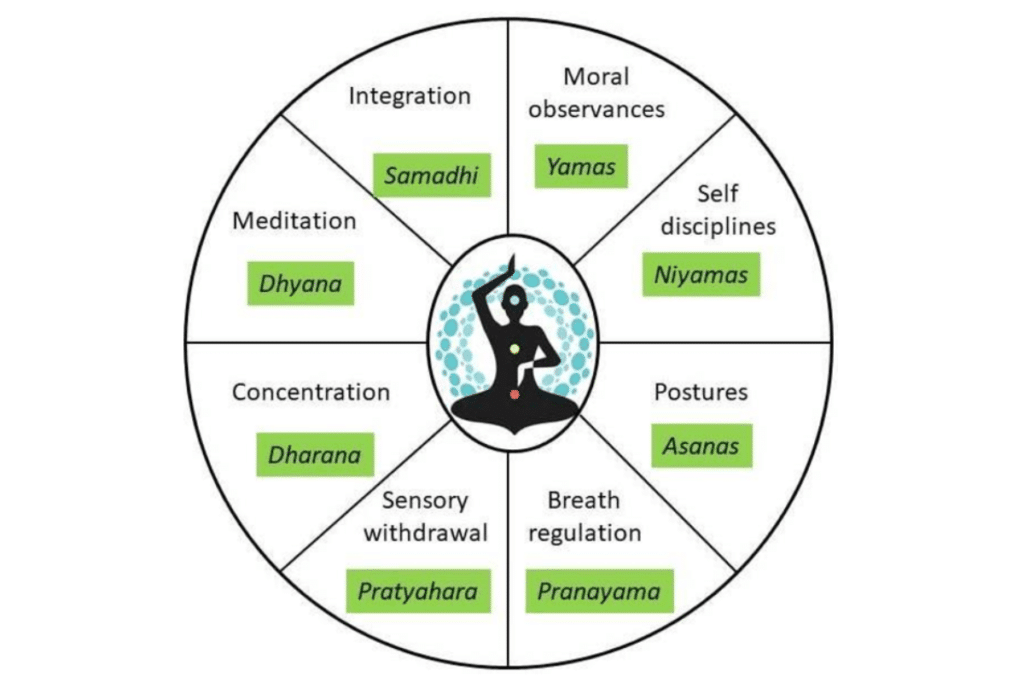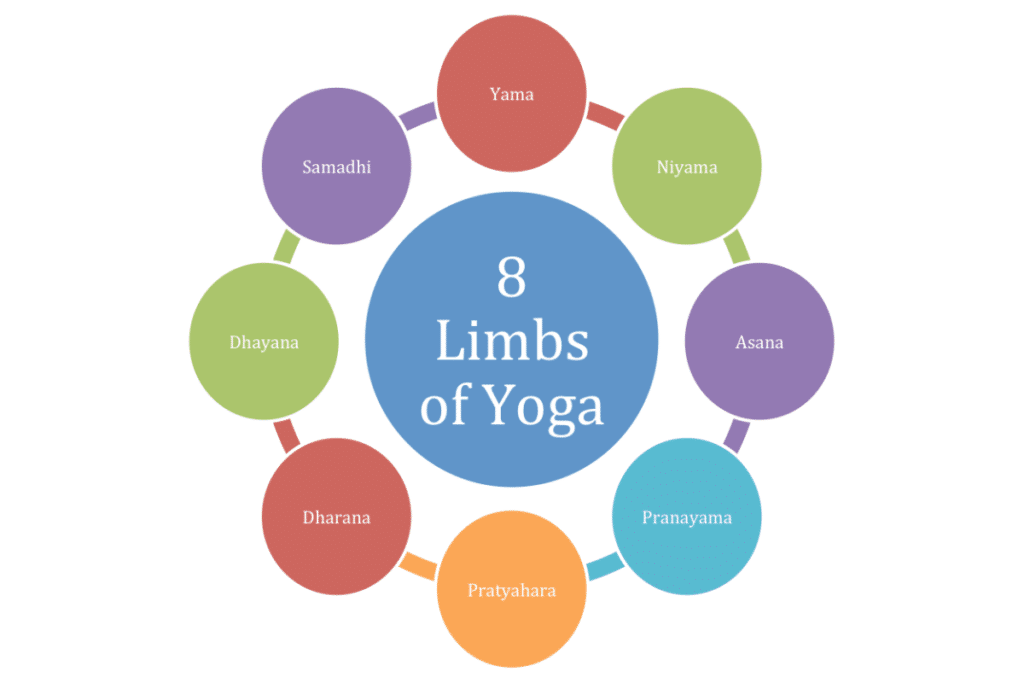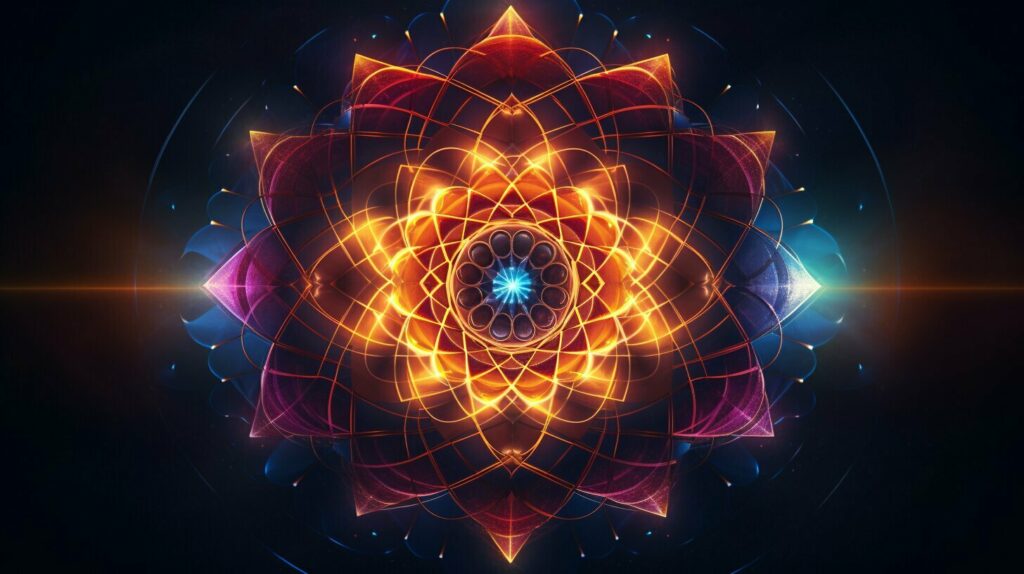The Eight Limbs of Yoga: Patanjali’s Path to Liberation

Yoga is an ancient spiritual practice that is over 6000 years old. Yoga is a Sanskrit word that means ‘union.’ Therefore, it symbolizes the goal of union with Divine source energy or with a state of pure awareness, also known as Moksha (liberation).
The ultimate purpose of yoga is to silence the thoughts and control the mind so that the true Self can be realized. When we recognize our true nature, we dissolve ignorance and illusion (the ego), gaining ultimate wisdom and transcending suffering. Patanjali’s Eight Limbs of Yoga is an excellent roadmap for this journey to liberation.
“Yoga is when the Self rests in its own being, in our own original nature, which is pure awareness.”~ Yoga Sutras of Patanjali
Unfortunately, here in the West, the ultimate purpose of yoga has become lost. We tend to see yoga as simply a form of exercise – the asana practice. Our goals with our yoga practice tend to be centered around making the body look good and achieving advanced postures for egoic reasons (Instagram, anyone…?)
While the benefits of yoga for calming the mind are also well-known (and are the goal of practice for some practitioners), we do not emphasize enough the immense power and potential that the yogic system can provide.

Patanjali’s Yoga Sutras
In fact, the asana practice is just one aspect of the full yogic system known as the Eight Limbs of Yoga. This is the primary philosophy of Patanjali’s Yoga Sutras – dating back to the 4th – 3rd Century BCE.
These Sutras teach us that our suffering and delusions are based on the view that we are one with the world we see around us. Patanjali’s dualistic view opposes most other monist Eastern spiritual philosophies, including the Hindu philosophy of Advaita Vedanta, and most forms of Buddhism.
Patanjali states that rather than one reality of which all phenomena are part of, including us, there are, in fact, two opposing forms of reality – Nature and Spirit. Nature is material – it is the world around us and our physical body. Nature is form, and so it changes over time. Spirit is our inner Self, our true Self. It is formless and unchanging. It is eternal. The realization of this unchanging and eternal Self is the goal of Patanjali’s system of the Eight Limbs of Yoga.
This philosophy explains that we experience this world through the prism of our senses and ego. This experience is based on ignorance of the truth that we are separate from the world. As a result, we experience attachment to worldly pleasures (positives) and aversion to suffering (negatives). Only when we can isolate the true Self (Spirit) and transcend our egoic ignorance and delusion that we are one with the world (Nature) can we achieve Moksha.
The Eight Limbs of Yoga
The Eight Limbs of Yoga is a system of right living and practice that enables us to control the mind and silence the thoughts so that we can achieve the goal – to realize the true nature of the Self.
Patanjali refers to this system as ‘Ashtanga,’ which means ‘eight limbs.’ Ashta = eight, anga = limb. We can view this system as a tree – Moksha is the trunk, and the eight branches (limbs) are the steps of the system to achieve Moksha.
The Eight Limbs of Yoga are as follows:
Each ‘limb’ or step of the system is a practical exercise towards self-realization. We can see it as a personal development practice, a self-help guide.
The First Limb – Yama
The yamas are concerned with ethics – our sense of morality and how we behave towards others and ourselves. We find guidelines about ethical conduct in most spiritual systems for many reasons. On the most fundamental level, behaving ethically leaves the mind pure and free from obstructions such as guilt, anger, revenge, worry, and fear.
If we have acted in an unskilful or corrupt way, we are likely to feel some negative emotion. This negative emotion maybe regret or guilt about what we have done, anger towards another person, or even fear about the consequences of our behavior. Ensuring our speech and actions are ethical and do not cause harm to ourselves or others frees the mental energy for more useful practices (the other limbs).
The yamas outline things that we should refrain from. There are five Yamas to observe as detailed below:
- Ahimsa – Refrain from harming (non-violence, Metta)
- Satya – Refrain from lying (truthfulness)
- Asteya – Refrain from stealing (generosity)
- Brahmacharya – Refrain from sense indulgence (right use of energy)
- Aparigraha – Refrain from greed (simplicity and contentment)
To make the yamas more user-friendly, and based on positive action, we can practice their constructive opposites.
Ahimsa – To refrain from harming any sentient being with our thoughts, speech, or actions, we can practice non-violence and Metta (loving-kindness). Non-violence is behaving in a way that does not damage the other person or being, whether physically, mentally, or emotionally. Metta is the cultivation of positive feelings and well-wishes towards the other. It takes non-violence to the next level – it is not merely the absence of harm, but also the presence of kindness.
Satya – To refrain from lying or false speech, we practice truthfulness. Before we speak, we can check whether our statement is true, useful, and positive. If not, we should reconsider sharing it. Lying is a form of causing harm, and therefore if we are following ahimsa, we should automatically be practicing truthfulness and positive speech.
Asteya – To refrain from stealing, we can practice generosity. Not only refusing to take what is not freely given to us but being generous with our own resources (time/money/energy). Again, it relates to ahimsa, and we can make it even more positive by turning it from the absence of stealing to the presence of generosity.
Brahmacharya – To refrain from sense indulgence and sexual misconduct, we can practice right use of energy. It is sometimes stated that this yama refers to sexual indulgence or misconduct, and the way to observe it is celibacy. However, these days it is commonly related to any waste of energy by indulging in pleasures of the senses – sexual contact, food, intoxicants, etc. To observe this yama, we can practice using our energy more skillfully, for example, all the other Eight Limbs of Yoga.
Aparigraha – To refrain from greed and covetousness, we can practice simplicity and contentment with what we have. This yama is also concerned with non-attachment. Gratitude is a helpful state of mind when observing this yama.

The Second Limb – Niyama
Niyamas are the positive aspects of the moral code. They refer to the behaviors and observances we should adopt to help us cultivate a clear mind.
- Saucha – Purity or cleanliness (mental and physical)
- Santosha – Contentment (satisfaction of our present experience)
- Tapas – Discipline (burning enthusiasm for our practice)
- Svadhyaya – Self-study (of the scriptures)
- Ishvara Pranidhara – Surrender (to the true Self or ultimate reality)
These behaviors help us to foster positive emotions, purify the mind and body, increase knowledge, and pave the way for a deeper resonance with the next steps in the Eight Limbs of Yoga system.
The Third Limb – Asana
Asana (the physical postures) is where we tend to focus most of our time and energy in the West as we practice Hatha yoga – a branch of yoga that focuses primarily on asana and pranayama. It is natural in our culture that we are drawn toward the tangible, the things we can see and feel. We also have an unhealthy preoccupation with body image, and unfortunately, any form of physical exercise will become entangled in this. It is ironic because the ultimate goal of yoga is freedom, and we are so far from that when we are caught up in how we look in our new yoga clothing or now we have managed to get into that ‘advanced’ pose.
However, as we begin to understand the other limbs, we can see the enormous potential for personal growth and spiritual development if we balance our asana practice with all the other parts of the Eight Limbs of Yoga system.
It is worth noting that the original purpose of the asanas was not to sculpt the body or achieve certain postures but to prepare the body for long periods of meditation. When the muscles and joints are flexible, the practitioner can remain seated and still for extended periods in comfort, allowing all concentration to be focused on meditation and reflection.
The other main purpose of asanas was that when combined with pranayama and dharana, they form full-body mudras (kaya). A mudra is a gesture that provokes a particular energy, much like a physical mantra. By using mudras (body or hand), we are channeling the energy flow in a specific way and for a particular purpose.

The Fourth Limb – Pranayama
Pranayama is practiced as part of Hatha yoga and is also part of the Eight Limbs of Yoga system. It is a set of breathing exercises that control the prana, or life force energy. Pranayama is a primary way to activate the Kundalini energy that resides in the Muladhara chakra at the base of the spine. Once we have awoken Kundalini, we can use other practices to sublimate it up towards the higher chakras. This rising helps us reach higher states of consciousness and move toward self-realization and Moksha.
On a physical level, pranayama enables us to switch from the sympathetic nervous system (fight or flight) to the parasympathetic nervous system (rest and digest). This improves wellbeing on a physical, mental, and emotional level. Another purpose of pranayama is to create balance. There are pranayama techniques that balance the left and right hemispheres of the brain, the conscious and unconscious mind, and the subtle energies of the being. Lastly, pranayama forms the bridge between the first four outward steps to the remaining four inward-focused limbs.
The Fifth Limb – Pratyahara
Now we begin on the ladder to more focused yet subtle states. No longer concerned with physical posture or breath, the attention moves inward. Pratyahara means sense withdrawal, and it is the first step towards meditation. When we sit with the intention to meditate, usually, the first thing we do is take a few deep breaths to focus the mind (pranayama) and then turn our awareness inwards and away from the outer experience (pratyahara). This sense withdrawal marks the beginning of the ‘heart of yoga’- meditation.
The Sixth Limb – Dharana
As we withdraw the senses, our point of steady inner focus becomes sharper. We use our dharana, our concentration, to still the mind and release us from turbulent thoughts. In meditation, we frequently use an ‘anchor,’ a point of focus to help keep our awareness inwards and on our practice. Often this anchor point is the breath itself, but it doesn’t have to be. Other points of focus are visualization, sound (guided meditation or music), mantra, and candle flame. Any focal point that helps to prevent the attention from wandering off and the senses inwardly focused will work. As we practice and develop dharana, we can rely less on a separate focus or anchor point, and concentration will come naturally to move us into the next stage.

The Seventh Limb – Dhyana
Moving to the seventh limb, we now encounter meditation. Dhyana means ‘to think of.’ But it does not refer to thinking in the usual way. While dharana is a single-pointed focus to hold the awareness inwards, dhyana is the point of focus with the added intention of realizing the truth of its nature. It often refers to reflection on the true Self and the nature of reality.
While we are absolutely practicing meditation during the previous ‘concentration’ stage of dharana, when we move into dhyana, we are bringing a sense of contemplation. It is this contemplation to which the name ‘to think of’ refers. It is a deeper understanding of the point of focus (whether that be a candle flame, a sound, or the concept of true Self), that moves us toward the final limb and ultimate goal of Patanjali’s Eight Limbs of Yoga system.
The Eighth Limb – Samadhi
Samadhi refers to ‘absorption.’ It is the state that is achieved when the contemplation of the point of focus results in the complete union of meditator and object. Remember, yoga means union. In samadhi, there is no distinction between the meditation as an act and the focus of the meditation. It is a state of supreme stillness where all sense desires and anxieties have been transcended. It is a state of pure presence, of complete realization.
The word itself means ‘equal view.’ Sama = same, dhi = to see. Therefore, when we reach the state of samadhi, we can observe the nature of reality with equality, our view is not clouded by sense desires, attachments, worries, or fear. This state is also known as pure awareness. We are able to glimpse this state occasionally, but for the majority of us, we don’t remain there long. It is only with constant practice of the Eight Limbs of Yoga system that we can completely release all that holds us back and permanently enter the state of samadhi. This is Moksha – enlightenment or true liberation.







[…] if realizing Samadhi means that the individual consciousness dissolves into the greater whole, it reflects the true essence of yoga. But what does that mean in terms of our journey through the eight limbs? What does it mean in […]
[…] Natalie Heath April 29, 2022 0 Comments […]
[…] such as thoughts, sounds, and sensations, disappear. We begin the process of unity, which is the fundamental definition of yoga. Thus begins the transition to […]
[…] […]
[…] […]
[…] Natalie Heath December 9, 2022 0 Comments […]
[…] […]
[…] […]
[…] Yoga (Patanjali’s Eight Limbs of Yoga – the yoga of […]
[…] to Patanjali in his Yoga Sutras, the practice of asana was primarily to make the body comfortable during meditation. It is summed […]
[…] Margo Schaefer April 28, 2023 1 Comment […]
[…] Patanjali’s Eight Limbs of Yoga, which is derived from the Hindu texts, Ahimsa is the first principle of conduct in the first limb […]